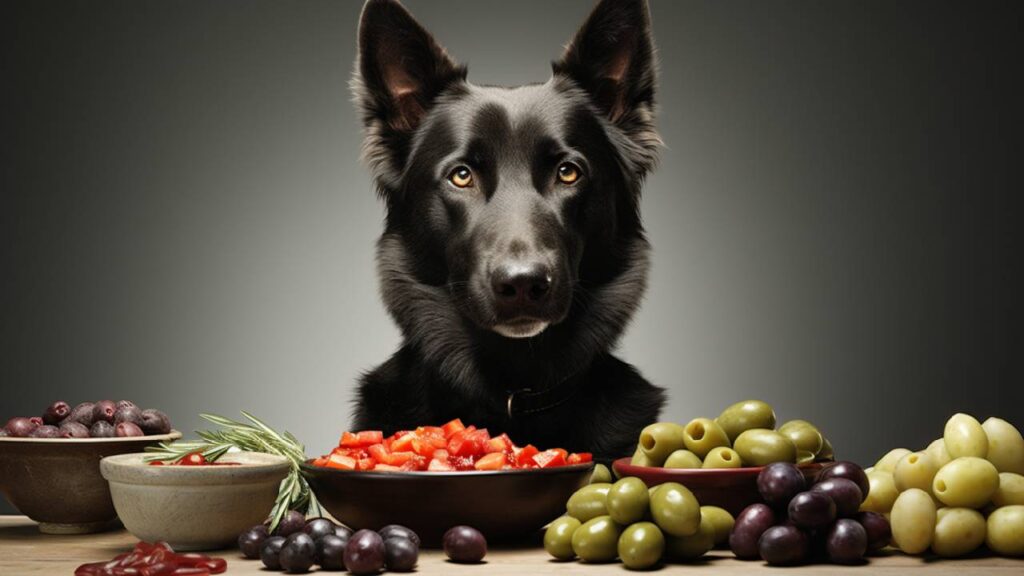Can your furry friend indulge in the delightful world of olives? The short answer is yes, dogs can enjoy olives in moderation. It’s an enticing thought to share your favorite snacks with your loyal companion, but there are crucial factors to consider before extending that olive branch.
This article explores the safety, potential benefits, and precautions surrounding dogs and olives to ensure your pup’s well-being. So, let’s delve into the world of canine-friendly olives and ensure your pet’s treat time is safe and satisfying.
Are Olives Safe for Dogs?
Safety should be your top priority when sharing olives with your canine companion. While olives are generally considered safe for dogs, it’s crucial to be aware of potential risks associated with this treatment. Here’s what you need to know:
- Sodium Content: Olives are salty, and excessive sodium intake can harm dogs. It can lead to increased thirst, urination, and, in severe cases, sodium ion poisoning.
- Portion Control: While olives can be a tasty addition to your dog’s diet, they should be considered an occasional treat rather than a regular meal. Keep track of the number of olives you offer and monitor your dog’s reaction.
- Choking Hazard: The pits or seeds inside olives pose a choking hazard to dogs. Make sure to remove these pits before giving olives to your pet.
- Digestive Sensitivity: Some dogs may have sensitive stomachs, and introducing new foods like olives can result in digestive upset, such as diarrhea or stomach discomfort.
By being mindful of these safety considerations, you can ensure that olives remain a tasty and harmless addition to your dog’s treat menu.
Potential Health Benefits
While olives should be given in moderation, they offer potential health benefits for your furry friend.

Here are the positive aspects of including olives in your dog’s diet:
Healthy Fats
Olives contain monounsaturated fats, which can contribute to a glossy coat and overall skin health. These healthy fats help maintain your dog’s skin’s natural moisture and can reduce dryness or flakiness.
Antioxidants
Olives are rich in antioxidants, such as vitamin E and polyphenols. These compounds help combat oxidative stress in your dog’s body, which can play a role in maintaining overall health and potentially reducing the risk of chronic diseases.
Immune System Support
The antioxidants in olives may also boost your dog’s immune system, helping them fight off illnesses and infections more effectively.
Improved Taste
Adding olives to your dog’s diet can provide variety and excitement in their meals. The different taste and texture can make mealtime more enjoyable for your pet.
Hydration
The water content in olives can contribute to your dog’s overall hydration, especially on hot days. However, water should still be your dog’s primary source of hydration.
Remember that these potential benefits should not be a reason to overindulge your dog in olives. Instead, offer them as an occasional treat alongside a balanced and appropriate diet to ensure your dog’s overall health and well-being.
Risks of Feeding Olives to Dogs
While olives can benefit dogs in moderation, it’s equally important to be aware of the potential risks associated with incorporating them into your pet’s diet. Here are some risks to consider:
- Excessive Sodium Intake: Olives are naturally high in sodium, which can lead to health problems if consumed in excess. Dogs are generally more sensitive to salt than humans, and too much sodium can increase thirst, urination, and, in severe cases, sodium ion poisoning.
- Choking Hazard: The pits or seeds inside olives pose a choking hazard to dogs. If your dog tries to swallow an olive pit whole or chews on it, it can lead to a choking emergency or dental problems.
- Digestive Upset: Introducing new foods like olives into your dog’s diet can sometimes result in digestive issues. Some dogs may experience diarrhea, upset stomach, or flatulence when consuming olives for the first time.
- Calorie Concerns: Olives are relatively calorie-dense, and overindulging in them can contribute to weight gain or obesity in dogs. If you’re using olives as treats, be mindful of your dog’s overall caloric intake, especially if they have weight management concerns.
While dogs can safely enjoy olives in moderation, understanding and managing these risks is essential to ensure your pet’s well-being. Always prioritize your dog’s safety and health when introducing new foods into their diet.
Fresh Olives or Canned?
When considering whether to offer olives to your dog, you may wonder whether fresh or canned olives are a better choice. Here’s a comparison to help you make an informed decision:
Fresh Olives
- Fresh olives can be safer for dogs since you have more control over the preparation process.
- You can choose between different varieties, such as green or black, based on your dog’s taste preferences.
- However, it’s essential to rinse and remove any excess salt from fresh olives to make them a healthier choice for your dog.
Canned Olives
- Canned olives, especially those labeled “pitted,” can be more convenient for dog owners.
- Canned olives can have a higher sodium content due to the brining or seasoning process.
- Some canned olives may contain additional ingredients like garlic or spices, which are not recommended for dogs. Always read the label to ensure there are no harmful additives.
Fresh olives generally allow more control over the preparation and sodium content, making them safer for dogs. However, if you choose canned olives, select low-sodium varieties without harmful additives and offer them sparingly as an occasional treat.
Types of Olives
When offering olives to your dog, you may wonder if one type is safer or more suitable.
Let’s explore the different types of olives and their potential considerations for your furry friend:
Green Olives:
- Green olives are typically less ripe than their black counterparts.
- They tend to have a slightly lower sodium content compared to black olives.
- Some dogs may find the milder flavor of green olives more palatable.
Black Olives
- Black olives are fully ripe, often with a more robust flavor than green olives.
- They may contain slightly more sodium than green olives but are still safe for dogs in moderation.
- Some dogs may prefer the richer taste of black olives, but individual preferences vary.
Which Type is Safer or More Suitable for Dogs?
Both green and black olives are generally safe for dogs when offered in moderation. However, if you’re concerned about sodium intake, you might opt for green olives due to their lower sodium content. Ultimately, your dog’s choice between green and black olives depends on their taste preferences and dietary considerations.
Preparing Olives for Dogs
Before giving olives to your dog, ensure they are adequately prepared. Remove pits, as they can be a choking hazard and are difficult for dogs to digest. You can also slice or mash olives for easier consumption. Remember to provide olives as an occasional treat rather than a regular part of your dog’s diet.
In conclusion, dogs can enjoy olives in moderation, but it’s essential to be mindful of the pits’ sodium content and potential choking hazards. Offering olives as an occasional treat can provide some health benefits, but always prioritize your pet’s safety and well-being.

FAQs
Can dogs eat olive pits?
No, olive pits should be removed before offering olives to your dog to prevent choking hazards.
How many olives can I give my dog?
It’s best to offer olives sparingly as an occasional treat. Monitor your dog’s reaction and adjust the portion size accordingly.
Are there any other fruits or vegetables dogs can enjoy safely?
Many fruits and vegetables, such as apples, carrots, and blueberries, can be healthy and safe dog treats.
Can olives be included in a homemade dog food recipe?
Yes, olives can be incorporated into homemade dog food recipes, but follow a balanced diet and consult your veterinarian for guidance.
Are there any signs of olive toxicity in dogs?
Signs of olive toxicity in dogs are rare but may include vomiting, diarrhea, or stomach discomfort. If you notice these symptoms, consult your vet.








Olives are a favorite snack of mine, but I’ve heard mixed things about giving them to dogs. Any olive-loving pups out there? 🫒🐾
I’m unsure if they’re safe for dogs